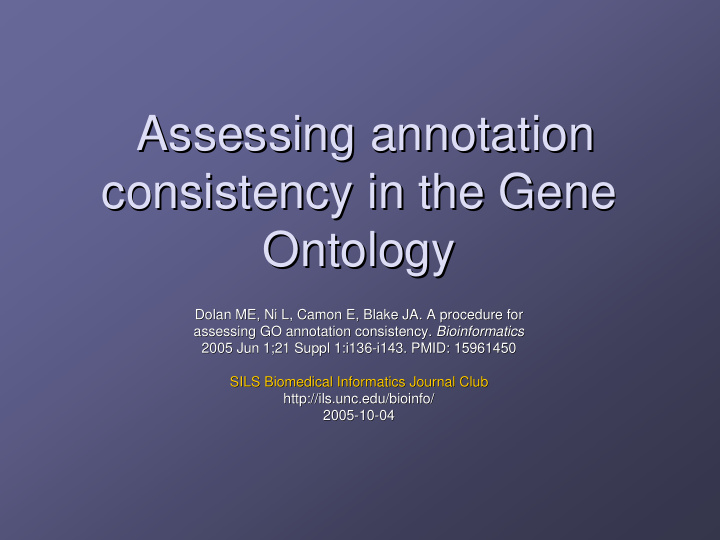



Assessing annotation Assessing annotation consistency in the Gene consistency in the Gene Ontology Ontology Dolan ME, Ni L, Camon E, Blake JA. A procedure for Dolan ME, Ni L, Camon E, Blake JA. A procedure for assessing GO annotation consistency. Bioinformatics assessing GO annotation consistency. Bioinformatics 2005 Jun 1;21 Suppl 1:i136- -i143. PMID: 15961450 i143. PMID: 15961450 2005 Jun 1;21 Suppl 1:i136 SILS Biomedical Informatics Journal Club SILS Biomedical Informatics Journal Club http://ils.unc.edu/bioinfo/ http://ils.unc.edu/bioinfo/ 2005- -10 10- -04 04 2005
Gene Ontology (GO) � A structure for classifying and linking genes and gene products from multiple organisms into three perspectives: � molecular function – what activities is the entity involved in? (ex: binding) � biological process – what process(es) is the entity involved in? (ex: cell growth) � cellular component – where is the entity located? (ex: nucleus) � organized in directed acyclic graphs (DAGs) - a ‘child’ entry can have many ‘parents’ 2 2
Graph types: Trees vs DAGs DAG Tree Source Nodes/ vertices Root node Root node Arc / Edge Parent Parent Target Path Child Child External (leaf) nodes Siblings Internal node “Nodes & edges” Depth = 2 “Vertices & arcs” (root = 0) Enables distance calculations 3 3
GO annotation 4 4 http://geneontology.org/GO.nodes.shtml
GO multi–organism annotation 5 5 http://geneontology.org/GO.annotation.example.shtml
Objectives (Dolan, et al.) � Multiple groups of individuals independently create GO annotations via differing methods and contexts � Goal: create methods to assess consistency of GO annotation across databases for orthologous genes 6 6
Methods � Check for consistency by “compar[ing] annotations between genes that share close evolutionary relationships [orthologous genes] , and are likely (although not necessarily) to function in similar ways” [i136] � Uses pre-existing curated orthology sets � Uses pre-existing simplified form of GO (GO_Slims) � Focused on Molecular Function ontology 7 7
Mouse/Human annotation consistency human mouse - gene H1 - gene M1 orthologous - gene H2 - gene M2 … … - gene Hn - gene Mn consistent? GO - GO G1 - GO G2 … - GO Gn 8 8
Data � 14,908 mouse-human orthology pairs in MGI dataset (2004-11-12) [current stats] � 11,860 curated mouse-human ortholog pairs � RQ: How many ortholog pairs have annotations in both databases? fig 3 fig 4 9 9
Results 2,137 matches from 1,572 jointly-annotated � pairs (some pairs had multiple annotations) 1,222 mismatches in seven case types: � 1. mismatches that correctly reflect the difference in the experimental evidence for the mouse and human genes; 2. incomplete annotation; 3. Annotation based on static out-of-date automated cross-reference tables; 4. annotation errors; 5. mismatches with ‘unknown molecular function’ for one gene and a known molecular function for its ortholog; 6. annotation mismatch due to the GO structure; 7. annotation mismatch due to our GO_Slim definition. 10 10
Results (table 2) 11 11
Results (fig 5) 12 12
Questions � The method’s precision is uncertain because orthologous genes don’t necessarily have the same function � How many of the other 13,336 orthologous pairs should be annotated with the same GO terms? (14,908 - 1,572) � The use of GO_Slims obscures mis-matches at more granular levels. � Is there a discovery component, or is this only useful for quality control? � How do we represent 3-way consistency? Or n -way? 13 13
Recommend
More recommend